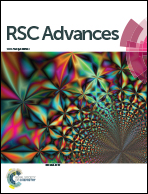Improved thermoelectric performance of CuGaTe2 with convergence of band valleys: a first-principles study†
Abstract
A high value (1.4) of figure of merit (ZT) of CuGaTe2 has been experimentally discovered by T. Plirdpring et al. [Adv. Mater. 24, 3622 (2012)]. In order to further enhance its thermoelectric properties, we investigated its electronic structure and thermoelectric properties by first-principles study. Large band-valley number and high convergence of the bottom conduction bands induced a large Seebeck coefficient and a high electrical conductivity of n-type CuGaTe2. So, for n-type CuGaTe2, the maximum ZT values 2.1 may be found at 950 K by suitable carrier concentration tuning, which results in a 25% increment in the ZT value compared with p-type CuGaTe2. Band decomposed charge density calculations indicate that the transport properties are mainly determined by the Cu and Te atoms at the valence-band maximum, in contrast, transport properties are simultaneously affected by the three kind of atoms at the conduction-band minimum. At high temperature, ab initio molecular dynamics calculations demonstrate that Cu atoms precipitated from their crystal matrices lead to a decrease in thermopower. Along the high symmetry point M, the charge density of all atoms is centrosymmetric. Maybe this centrosymmetric electronic structure leads to the conduction band valley convergence at the M point.


 Please wait while we load your content...
Please wait while we load your content...